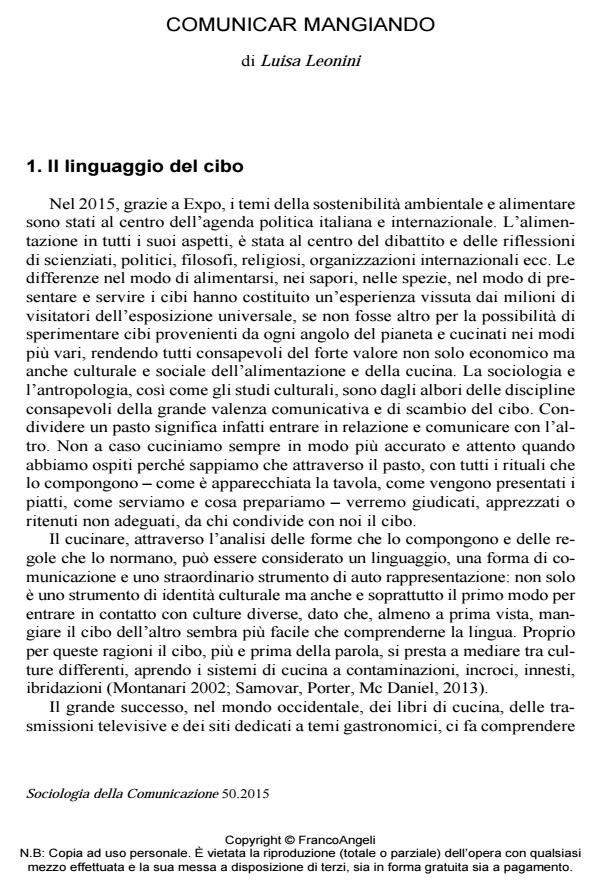Comunicar mangiando
Titolo Rivista SOCIOLOGIA DELLA COMUNICAZIONE
Autori/Curatori Luisa Leonini
Anno di pubblicazione 2016 Fascicolo 2015/50 Lingua Italiano
Numero pagine 7 P. 114-120 Dimensione file 179 KB
DOI 10.3280/SC2015-050011
Il DOI è il codice a barre della proprietà intellettuale: per saperne di più
clicca qui
Qui sotto puoi vedere in anteprima la prima pagina di questo articolo.
Se questo articolo ti interessa, lo puoi acquistare (e scaricare in formato pdf) seguendo le facili indicazioni per acquistare il download credit. Acquista Download Credits per scaricare questo Articolo in formato PDF

FrancoAngeli è membro della Publishers International Linking Association, Inc (PILA)associazione indipendente e non profit per facilitare (attraverso i servizi tecnologici implementati da CrossRef.org) l’accesso degli studiosi ai contenuti digitali nelle pubblicazioni professionali e scientifiche
The article discusses the role of food as an instrument of identity and a channel of contact through cultures. This is argued drawing from the food practices of international migrants in the context of the global flows of people and commodities in present day Italy. In this regard, food plays an essential role in the rebuilding of a familiar context in which migrants can feel temporarily "at home". At the same time, food is an important form of communication and contact between different cultures and social contexts. In this process of exchange both migrants and hosts, food habits and diets are modified as they incorporate elements and ingredients from each other, making more porous the boundaries of difference.;
Keywords:Ethnicity, family, food, migration, culture, language.
- Appadurai A. (1988), The Social life of things, Cambridge University Press, Cambridge, Mass.
- Bourdieu P. (1972), Esquisse d’une théorie de la pratique, Droz, Genève.
- Colombo E., Navarini G., Semi G. (2008), I contorni del cibo, in Neresini F., Rettore V. (a cura di), Cibo, cultura e identità, Carocci, Roma.
- Coviello L. (1967), The Social background of the Italo-American School Child, Brill, Leiden.
- Flandrin J., Montanari M. (ed.) (1997), Storia dell’alimentazione. Laterza, Roma.
- Gunew S. (2004), Haunted Nations: The Colonial Dimensions of Multiculturalisms. Routledge, London.
- La Cecla F. (1997), Il malinteso, Laterza, Roma.
- La Cecla F. (2002), La pasta e la pizza, il Mulino, Bologna.
- Leonini L. (2005), Stranieri e italiani: una ricerca tra gli adolescenti figli di immigrati nelle scuole superiori, Donzelli, Roma
- Leonini L., Rebughini, P. (2012), The Consumption Styles of Immigrant Families in Italy: Identifications, Status, and Practices, «Family and consumer sciences research journal», 41 (2), pp. 161-171.
- Montanari M. (a cura di) (2002), Il mondo in cucina. Storia, identità, scambi, Laterza, Roma.
- Neresini F., Rettore V. (2008), Cibo, Cultura, Identità, Carocci, Roma.
- Samovar L., Porter R., McDaniel E. (2013), Communication between Cultures, Wadsorth, Boston.
- Sollors W. (1991), The Invention of Ethnicity. Oxford University Press, Oxford, New York.
Luisa Leonini, Comunicar mangiando in "SOCIOLOGIA DELLA COMUNICAZIONE " 50/2015, pp 114-120, DOI: 10.3280/SC2015-050011